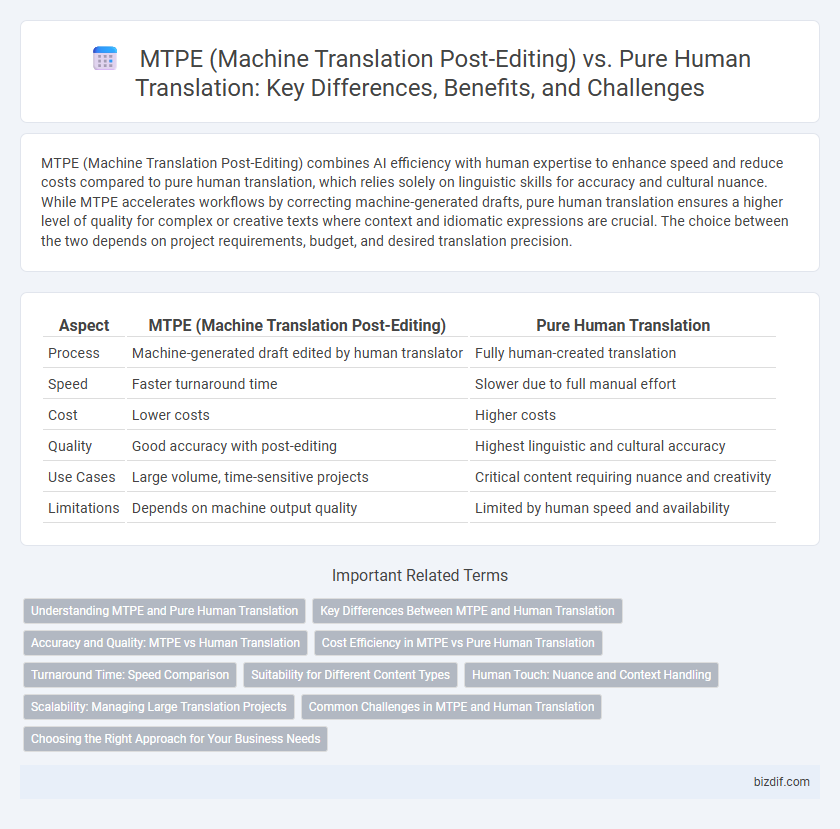MTPE (Machine Translation Post-Editing) combines AI efficiency with human expertise to enhance speed and reduce costs compared to pure human translation, which relies solely on linguistic skills for accuracy and cultural nuance. While MTPE accelerates workflows by correcting machine-generated drafts, pure human translation ensures a higher level of quality for complex or creative texts where context and idiomatic expressions are crucial. The choice between the two depends on project requirements, budget, and desired translation precision.
Table of Comparison
| Aspect | MTPE (Machine Translation Post-Editing) | Pure Human Translation |
|---|---|---|
| Process | Machine-generated draft edited by human translator | Fully human-created translation |
| Speed | Faster turnaround time | Slower due to full manual effort |
| Cost | Lower costs | Higher costs |
| Quality | Good accuracy with post-editing | Highest linguistic and cultural accuracy |
| Use Cases | Large volume, time-sensitive projects | Critical content requiring nuance and creativity |
| Limitations | Depends on machine output quality | Limited by human speed and availability |
Understanding MTPE and Pure Human Translation
MTPE (Machine Translation Post-Editing) leverages automated translation output refined by human editors to improve accuracy and fluency, significantly reducing turnaround time compared to pure human translation. Pure human translation relies solely on linguistic expertise and cultural understanding without machine assistance, ensuring higher context-specific nuances and creativity. Both methods serve different needs: MTPE balances speed and cost-effectiveness, while pure human translation emphasizes quality and subtlety in complex content.
Key Differences Between MTPE and Human Translation
MTPE combines the speed of machine translation with human expertise to refine output for accuracy and naturalness, while pure human translation relies solely on human skill for initial content creation, ensuring higher linguistic nuance and cultural appropriateness. MTPE significantly reduces turnaround time and costs by correcting machine-generated drafts, whereas pure human translation demands extensive time and resources for producing original texts. Quality control in MTPE focuses on editing and error correction, contrasting with the comprehensive creative process inherent to pure human translation.
Accuracy and Quality: MTPE vs Human Translation
MTPE (Machine Translation Post-Editing) combines automated output with human refinement to enhance speed while maintaining acceptable accuracy, but pure human translation often achieves higher linguistic quality and cultural nuance. MTPE is effective for large volumes and time-sensitive projects, though it may introduce subtle errors or unnatural phrasing requiring skilled post-editors. Human translation excels in specialized or creative content demanding precise terminology and stylistic consistency, ensuring superior overall quality compared to MTPE.
Cost Efficiency in MTPE vs Pure Human Translation
MTPE significantly reduces overall translation costs by combining machine translation speed with human quality control, making it more cost-efficient than pure human translation. While pure human translation offers higher accuracy, its longer turnaround times and labor intensity increase expenses. Businesses seeking a balance between quality and budget often prefer MTPE for scalable and cost-effective multilingual content.
Turnaround Time: Speed Comparison
MTPE significantly reduces turnaround time compared to pure human translation by leveraging pre-translated content that editors refine for accuracy and fluency. Human translators working from scratch typically require more time to produce high-quality translations, especially for complex or technical documents. By combining machine efficiency with human expertise, MTPE accelerates delivery without compromising essential content quality.
Suitability for Different Content Types
MTPE excels in processing large volumes of technical and repetitive content swiftly, making it ideal for user manuals, product descriptions, and software interfaces. Pure human translation is better suited for creative, literary, and highly nuanced texts such as marketing materials, legal documents, and literary works where cultural context and tone are critical. Choosing between MTPE and human translation depends on factors like content complexity, desired accuracy, and turnaround time requirements.
Human Touch: Nuance and Context Handling
MTPE enhances efficiency by combining machine translation speed with human expertise to refine nuance and context, ensuring translations resonate with cultural and contextual accuracy. Pure human translation excels in capturing subtle idiomatic expressions, emotional undertones, and complex linguistic variations that machines often miss. The human touch in post-editing bridges gaps in machine output, delivering content with precise tone and context relevance essential for high-quality localization.
Scalability: Managing Large Translation Projects
MTPE offers superior scalability for managing large translation projects due to faster turnaround times and automated initial drafts, enabling efficient handling of high-volume content. Pure human translation, while delivering higher accuracy and cultural nuance, often requires more time and resources, limiting scalability for extensive projects. Integrating MTPE allows organizations to balance quality and speed, optimizing workflow for large-scale multilingual content production.
Common Challenges in MTPE and Human Translation
MTPE faces challenges such as handling inconsistent machine output, managing translation errors, and ensuring contextual accuracy, which often require extensive linguistic expertise to refine. Pure human translation struggles with maintaining consistency across large projects and balancing cultural nuances without automation support. Both methods must address issues of terminology accuracy, style coherence, and time constraints affecting overall translation quality.
Choosing the Right Approach for Your Business Needs
MTPE combines the speed and cost-efficiency of machine translation with human expertise to refine accuracy, making it ideal for large volumes of content with tight deadlines. Pure human translation ensures high-quality, culturally nuanced results, which is crucial for sensitive or brand-critical materials where precision is paramount. Businesses should assess project complexity, turnaround time, and budget to select the most effective translation approach.
MTPE (Machine Translation Post-Editing) vs Pure Human Translation Infographic

 bizdif.com
bizdif.com